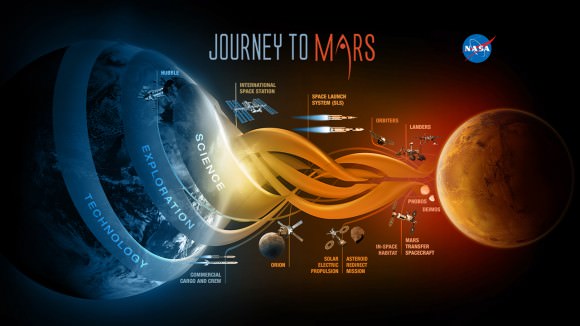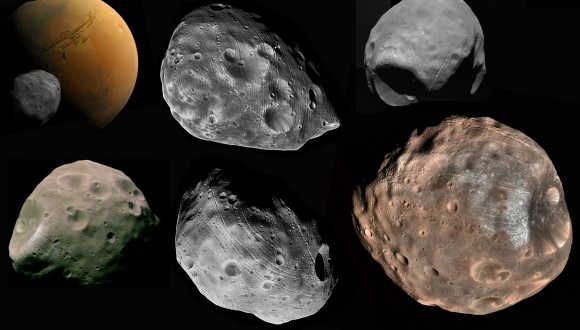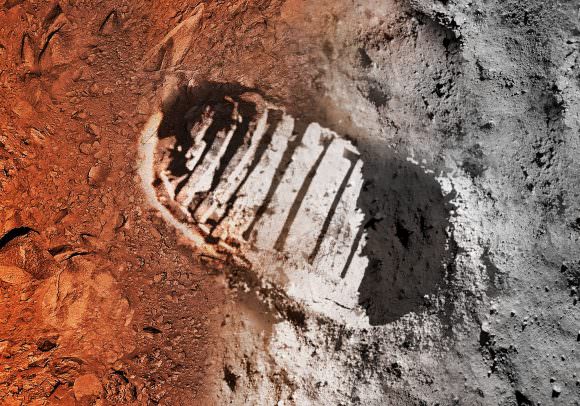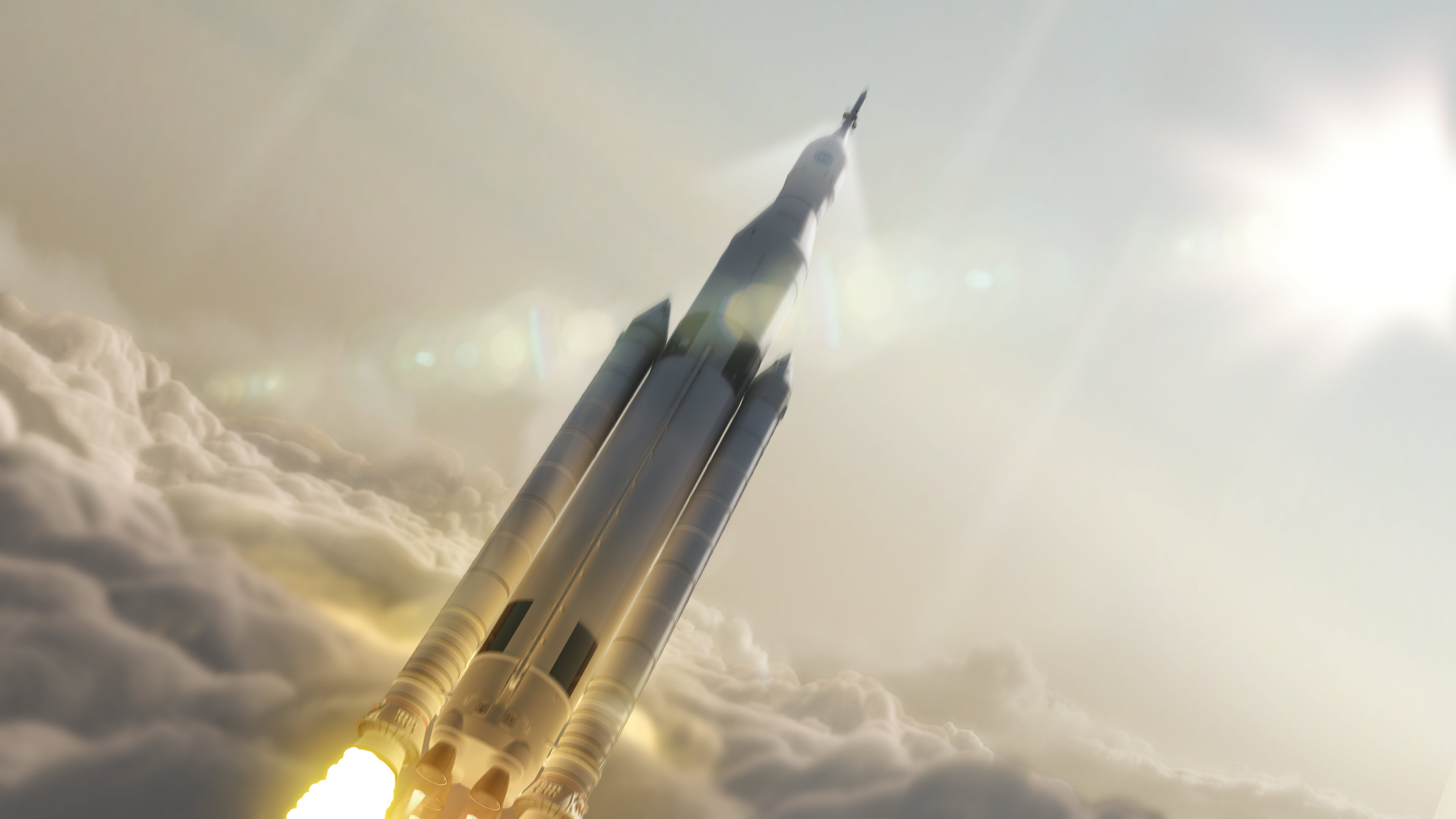Since the Authorization Act of 2010, NASA has been pushing ahead with the goal of sending astronauts to Mars by the 2030s. The latter part of this goal has been the subject of much attention in recent years, and for good reason. Sending crewed missions to the Red Planet would be the single-greatest initiative undertaken since the Apollo era, and the rewards equally great.
However, with the scheduled date for a mission approaching, and the upcoming presidential election, NASA is finding itself under pressure to show that they are making headway. Despite progress being made with both the Space Launch System (SLS) and the Orion Multi-Purpose Crew Vehicle, there are lingering issues which need to be worked out before NASA can mount its historic mission to Mars.
One of the biggest issues is that of assigned launched missions that will ensure that the SLS is tested many times before a crewed mission to Mars is mounted. So far, NASA has produced some general plans as part of it’s “Journey to Mars“, an important part of which is the use of the SLS and Orion spacecraft to send a crew beyond low-Earth orbit and explore a near-Earth asteroid by 2025.

This plan is not only intended to provide their astronauts with experience working beyond LEO, but to test the SLS and Orion’s capabilities, not to mention some vital systems – such as Solar Electric Propulsion (SEP), which will be used to send cargo missions to Mars. Another major step is Exploration Mission 1 (EM-1), the first planned flight of the SLS and the second uncrewed test flight of the Orion spacecraft (which will take place on September 30th, 2018).
However, beyond this, NASA has only one other mission on the books, which is Exploration Mission 2 (EM-2). This mission will involve the crew performing a practice flyby of a captured asteroid in lunar orbit, and which is scheduled for launch in 2023. This will be the first crewed test of the Orion spacecraft, and also the first time American astronauts have left low-Earth orbit since the Apollo 17 mission in 1972.
While significant, these mission remain the only two assigned flights for the SLS and Orion. Beyond these, dozens more have been proposed as part of NASA’s three phase plan to reach Mars. For instance, between 2018 and the 2030s, NASA would be responsible for launching a total of 32 missions in order to send the necessary hardware to near-Mars space before making crewed landings on Phobos and then to Mars.
In accordance with the “Evolvable Mars Campaign” – which was presented last year by NASA’s Human Exploration and Operations Mission Directorate (HEOMD) – Phase One (the “Earth Reliant” phase) of this plan would involve two launches in 2028, which would be responsible for transporting a habitation module, an SEP module, and a exploration vehicle to cis-lunar space.
This would be followed by two SLS flights in 2029, bringing the Trans-Earth Injection (TEI) stage to cis-lunar space, followed by a crew to perform the final checks on the Phobos Hab. By 2030, Phase Two (known as the “Proving Ground” phase) would begin with the last elements – the Earth Orbit Insertion (EOI) stage and taxi elements – being launched to cis-lunar orbit, and then all the equipment being sent to near-Mars space for pre-deployment.
By 2031, two more SLS missions would take place, where a Martian Hab would be launched, followed in 2032 by the launches of the Mars Orbit Insertion (MOI) and Trans-Mars Injection (TMI) stages. By 2033, Phase Three (the “Earth Independent” phase) would begin, where the Phobos crew would be transported to the Transit Hab, followed by the final crewed mission to the Martian surface.
Accomplishing all of this would require that NASA commit to making regular launches over the next few years. Such was the feeling of Bill Gerstenmaier – NASA’s Associate Administrator for Human Exploration and Operations – who recently indicated that NASA will need to mount launches at least once a year to establish a “launch cadence” with the SLS.
Mission proposals of this kind were also discussed at the recent Aerospace Safety Advisory Panel (ASAP) meeting – which meets annually to discuss matters relating to NASA’s safety performance. During the course of the meeting, Bill Hill – the Deputy Associate Administrator for Exploration Systems Development (ESD) in NASA’s Human Exploration and Operations Mission Directorate (HEOMD) – provided an overview of the latest developments in NASA’s planned mission.

By and large, the meeting focused on possible concepts for the Mars mission, which included using SEP and chemical propellants for sending hardware to cis-lunar space and near-Mars space, in advance of a mission to Phobos and the Martian surface. Two scenarios were proposed that would rely to these methods to varying extents, both of which called for a total of 32 SLS launches.
However, the outcome of this meeting seemed to indicate that NASA is still thinking over its long-term options and has not yet committed to anything beyond the mission to a near-Earth asteroid. For instance, NASA has indicated that it is laying the groundwork for Phase One of the Mars mission, which calls for flight testing to cis-lunar space.
However, according to Hill, NASA is currently engaged in “Phase 0” of the three phase plan, which involves the use of the ISS to test crew health via long duration space flight. In addition, there are currently no plans for developing Phases Two and Three of the mission. Other problems, such as the Orion spacecraft’s heatshield – which is currently incapable of withstanding the speed of reentry coming all the way from Mar – have yet to be resolved.
Another major issue is that of funding. Thanks to the Obama administration and the passage of the Authorization Act of 2010, NASA has been able to take several crucial steps towards developing their plan for a mission to Mars. However, in order to take things to the next level, the US government will need to show a serious commitment to ensuring that all aspects of the plan get the funding they need.
And given that it is an election year, the budget environment may be changing in the near future. As such, now is the time for the agency to demonstrate that it is fully committed to every phase of its plan to puts boots on the ground of Mars.
On the other hand, NASA has taken some very positive strides in the past six years, and one cannot deny that they are serious about making the mission happen in the time frame it has provided. They are also on track when it comes to proving key concepts and technology.
In the coming years, with flight tests of the SLS and crewed tests of the Orion, they will be even further along. And given the support of both the federal government and the private sector, nothing should stand in the way of human boots touching red soil by the 2030s.

Further Reading: NASA Spaceflight.com


“nothing should stand in the way of human boots touching red soil” Oh yeah, it’s called ‘planetary protection’ (works both ways). Funny how everyone pretends it doesn’t exist when talking about the human Mars program.
For all practical purposes the PPP doesn’t exist when it comes to exploration or commercial utilization/colonization. Everyone knows it has to give. It was a good idea to jump start astrobiology with once in a time, but now it seems a ludicrous quirk of history for many. The stated rationale of virulence is impossible, and genome sequencing would distinguish between extant and colonizing life. It could mess with early efforts to find biomarkers, but manned exploration makes those efforts easier as well, so that small matter could be a toss up.
While we should make every effort to comply with NASA’ planetary protection limitations, we need at the same time to say that Mars is a place for human use. Once it has been established that any native Martian organisms are harmless to the human biosphere. Then the planet should be open to settlement regardless of the consequences to astrobiological science. The survival of OUR species is immeasurably more important than satisfying the curiosity of a few boffins, who are poorly paid for good reason.
NASA may make it to Mars in the 2030’s (or not), but they may find SpaceX already there with the SpaceX corporate flag already planted at the SpaceX base and colony.
It might be a pretty anti-climatic mission for NASA. Especially since they’ll be disposing of so much expensive hardware (all pieces of the SLS) along the way.
“the Orion spacecraft’s heatshield – which is currently incapable of withstanding the speed of reentry coming all the way from Mar [sic]”-
I am befuddled by this claim. Being transported in Orion all the way from Mars would be, like someone else in this game would say, like trying to live in a SUV for 6 months.
NASA’s tentative plans for Mars visits, as seen in the tentative SLS manifest, calls for a propulsive habitat that transports the astronauts back and forth from Moon orbits to Mars orbits. Orion would only need to handle a lunar return heat load, like Apollo.
I think that requirement has already been tested during the EFT-1 mission, which is a prelude to manned and manned lunar orbit missions. “This mission design corresponds to the Apollo 4 mission of 1967, which validated the Apollo flight control system and heat shield at re-entry conditions planned for the return from lunar missions.” [ https://en.wikipedia.org/wiki/Exploration_Flight_Test_1 ; https://en.wikipedia.org/wiki/Orion_(spacecraft)#Orion_Program_mission_schedule ]
Well, some have started to question the narrative of Apollo, since NASA is struggling now to replicate feats they apparently accomplished 50 years ago, in a far shorter timeframe, with exponentially inferior technology.
Matt, overall this was a killer article. I do question your belief that NASA is committed to achieving this mission in the timeframe provided. As you yourself outlined, they aren’t remotely close to the degree of long-term planning needed, and I have no idea how they are going to begin launching 30+ missions there, starting only 2 years from now. For literally 15 years, the agency has been able to relax with some indefinite finish line, always pushing it farther down the road. But now the ending is in sight, and they don’t appear remotely prepared for it.
Don’t be surprised if an election or war “unfortunately” derails the timeframe once again.
I was 13 years old when the Viking probes landed on Mars, and we got to see the first color pictures of the surface of Mars. I was a very excited boy. A year earlier we started cooperating with the Soviets (linking up their Soyuz capsule to our Apollo capsule). We were only 4 years past the last human landing on the Moon, (and now we had a probe on Mars with color pictures of the surface). Plus, we were only one year away from the first experimental flight of the full size shuttle demonstrator, Enterprise.
We were going to space in a big, BIG way…
A decade goes by. Then another. Then another. And still another. We’re now 40 years past America’s Bicentennial where the United States landed two probes on Mars. The 13 year old boy that I was is now a 53 year old man at the twilight of my career with only another 20 or so years of expected life. Twenty years from now (2036 – 60 years after Viking) will NASA have boots on the ground on Mars?
I’m not going to hold my breath. I had been holding my breath for many, many decades, but I finally had to breathe again. This time around, I think I’ll put my money on SpaceX. Why? The guy who controls the money there seems to have the motivation and ambition to get there. Desire and money is all that really matters I think.
That’s a great post. I tend to believe it’s not administrative NASA incompetence, as it is intentional stalling and placation, as the serious space exploration is all now on the Black Budget. The US Air Force Space Program is actually better funded than NASA, yet we never hear anything about what they do.
“Black Budget” ok……. *turns off attention*
Yes, and that’s the problem in America. Most Americans simply “turn off their attention” while NASA is underfunded, yet billions more are spent on classified space programs.
According to the Department of Defense itself, over $3.3 billion dollars were spent last year alone. Check it out for yourself if you don’t believe me:
http://www.bga-aeroweb.com/DoD-Space-Programs.html
When I hear the words “Black Budget”, I immediately think of Dick Hoagland and that crew. If anything like his banter, is what you’re implying, then I turn away because it’s nonsense. As your above comment about the Apollo narrative being questioned implies “Moon Hoax”, I rest my case…
Well, keep in mind that Hoagland did work at NASA itself for a time. Even independent of authors like that, the current progress raises more questions than answers.
Why is the SLS basically just a larger version of a Saturn V, technology that we had way back in the 1960’s? Are we really using 1960’s-era technology to get to the Moon 50 years later? And why is the SLS no longer even destined for the Moon, according to Charles Bolden, when that was the main way NASA was able to sell the public on it? Why did NASA itself release a technical report stating that the implications of launching from the Moon’s “gravitational well”, and the effect of radiation, etc. on astronauts on the surface were unknown, even though we apparently collected a wealth of data from Apollo 8 through Apollo 17?
Even independent of all of the photographic anomalies researchers are now finding by analyzing images with advanced software not available decades ago, there are countless legitimate questions about the Moon landings to consider today.
His claims that he ever worked for NASA are dubious and even if he had, doesn’t mean he isn’t bat shit crazy and wrong. And the ironic thing here is that for all his nutso nonsense, one thing he does say forthright is that NASA DID go to the moon. In fact much of his so called evidence for ruins there on are derived from Apollo images taken by the astronauts. Any photographic anomalies researchers are now finding is looking for “proof” after determining the cause without it and then sifting through data to prove what they already “know”; that’s backwards science. It’s all been debunked thoroughly and I’m not sure why I’m wasting my time righ
Actually, its not all “been debunked thorougly”, Jeffrey. There are a group of European and Russian scientists taking serious, detailed looks at aspects of these missions, but because they are not American, you don’t hear anything about it unless you go to look for it.
If you get a chance, check out some of their work here. I don’t know where I stand on these missions, but some of their research is quite thorough, and raises questions that have so far been ignored.
http://www.aulis.com/
I went there just now. Any site with products for sale, let alone that many, is not a serious scientific site. They’re just selling products to easily fooled nuts. If they were actual scientists, they’d publish their findings in peer reviewed journals; that’s how science works. Speaking of, your claim that “…because they are not American, you don’t hear anything about it unless you go to look for it” is obvious nonsense given that actual scientists from all over the world make news every single day. If you’re assertion was correct, how can we know anything about, oh, CERN, located in Europe. Being not American and thus hidden away from popular media is as ridiculous a claim as I’ve heard. That’s just demonstrably COMPLETELY false. BTW, I love the 9/11 and JFK articles also featured there…… LMAO.
It sounds like you didn’t take the time to review any of their actual research. You basically just checked out the home page, drew a couple of shoot-from-the-hip conclusions, and reverted back to attack mode.
It’s this uncomfortability- the unwillingness of people to review ideas outside of established history- that is crushing our progress in space exploration today.
In the meantime, ask yourself, why are we not going back to the Moon? Why, after decades worth of advances and 10+ years’ worth of delays, scrapping of the Constellation program, and re-branding it as SLS, are we trying to get to Mars with 50+ year old technology, with no actual mission outline or timeframe in sight?
Why does NASA say we have no knowledge of how the Van Allen Belts or radiation on the Moon’s surface will affect astronauts, even though we should have at least (Apollo 8, 10, 11, 12, 13, 14, 15, 16, 17) NINE missions’ worth of valuable data from beyond Earth orbit?
There are a lot of serious questions being completely ignored, which is a big part of the reason we are stuck where we are.
Why would I read anything that pseudoscientists write on a conspiracy site? They aren’t publishing in real scientific journals and they’re sharing their info on a site like that. That’s like saying “You didn’t bother to read the crayon scribbles”. They’re obviously not credible scientists. What part of that confuses you? I’ve read all that before and heard it all logically and carefully explained with actual science and facts. Also, every point you make HAS been thoroughly debunked many times. Rather than regurgitating hours worth of material here, I’ll post links and save some time:
http://podcast.sjrdesign.net/tree.html (see “moon hoax” section)
http://www.badastronomy.com/bad/misc/apollohoax.html
http://www.theskepticsguide.org/podcast/sgu/481
http://www.clavius.org/
Here’s a single for instance regarding your Van Allen belt claims:
http://www.clavius.org/envrad.html
Here is a quote from one of the articles, in which they reference the NASA Augustine report, which lists radiation concerns as a huge limiting factor, and does not acknowledge any data that should’ve been gathered during multiple Apollo trips:
Radiation beyond Low-Earth Orbit
Regarding the radiation limits for travelling beyond LEO, ‘NASA relies on external guidance from the National Academy of Sciences and the National Council on Radiation Protection and Measurements (NCRP) for establishing dose limits. Due to the lack of data and knowledge, the NAS and NCRP recommended that radiation limits for exploration missions could not be determined until new science data and knowledge [were] obtained.’ (Arch. Study, 2005 p.109)
The next year, in swift response to NASA’s request, the NCRP produced a report with a title to puzzle an unprepared reader: Information Needed to Make Radiation Protection Recommendations for Space Missions Beyond Low-Earth Orbit (NCRP, 2006). By this, the NAS admits that there is no substantial information available on cosmic radiation beyond LEO, including data on lunar surface radiation, despite the alleged achievements of Apollo.
The Augustine Committee quotes another report, this time from the National Research Council (NRC, 2008), which largely confirms the problem: ‘Lack of knowledge about the biological effects of and responses to space radiation is the single most important factor limiting the prediction of radiation risk associated with hu
OK
NASA’, or the Planetary Societies plans for a Mars mission, are not realistically, cost effective, safe, or robust enough. Space X has an architecture which is said meet these conditions. We should wait to hear what Mr. Musk presents on 9/30 before we begin any serious conversation about a Mars program.